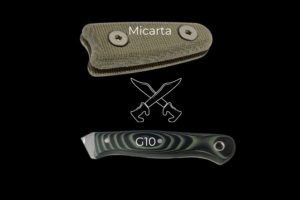When we talk about a knife, we immediately think of the sharp blade.
But the handle is equally important. It plays an important role in terms of handling as well as design.
Of course, there is not one but rather many materials used to make knife handles, the list would be so long that we will concentrate on the main ones, those that you will encounter most of the time.
Today we will walk through the knife handle materials for better understanding before choosing one.
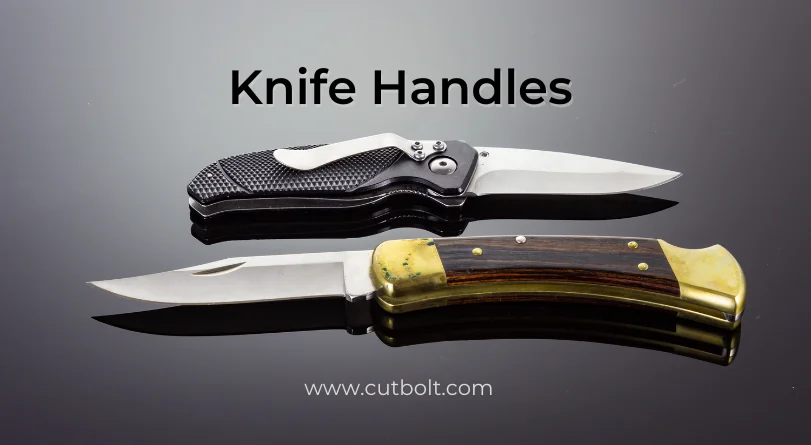
Choosing the right knife handle materials
When buying knives, many people focus on the blade as well as the aesthetics of the handle. However, you should know that materials have different properties that are important to know in order to make an informed choice.
The material chosen has an influence on the solidity, weight, ergonomics, and of course the final price of the knife. As you will have understood, we are therefore far from a simple question of style!
To make it easier to navigate, materials can be classified into different categories: metals, plastics, organics and composites.
1. Metals
Metals can be separated into two large parts, namely pure metals most often obtained from mine rocks as well as alloys obtained by mixing a metal with another component. All this with a view to improving its characteristics and properties.
1.1. Pure metals used as knife handle materials
- Aluminum is one of the most widely used materials on earth. It is frequently used in the manufacture of knife handles, as it is lightweight and corrosion-resistant. Another advantage of aluminum, and not the least, is the possibility of easily decorating it with printed patterns, especially in three dimensions, as the Martinez Albainox brand does so well. Be careful though because there are people who have allergies to aluminum.
- Copper is one of the few pure metals that can be colored. In fact, copper handles have an attractive salmon-pink surface. It is a material with good electrical/thermal conductivity, as well as corrosion resistance. Copper is used in many brands, including Black Fox and Higonokami, the brand behind the popular Japanese pocket knife.
- Titanium is one of the finest materials used in the construction of knife handles. It can be recognized by its metallic white appearance, in keeping with the style of the blade. Titanium has very interesting properties, such as corrosion resistance and excellent mechanical properties (notably resistance to deformation). If you’re interested in titanium handles, we recommend you take a look at knives from the Kizer brand. However, titanium is a relatively expensive material.
- Zinc, a gray metal, is rarely used pure in cutlery, but is used extensively in alloys, as you’ll see below. This heavy metal has good corrosion resistance and excellent electrical/thermal conductivity, but has a tendency to tarnish.
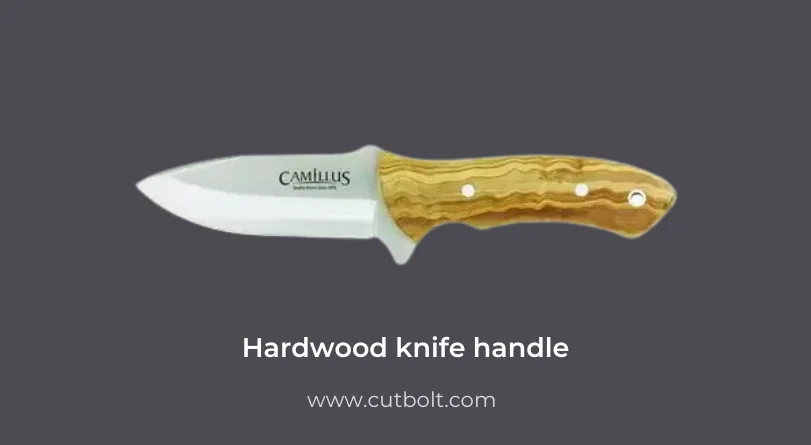
1.2. Alloys used as knife handle materials
- Brass is created by alloying zinc and copper. It is not difficult to identify because of its color, which is usually yellow/gold but can also be pink. It is both corrosion-resistant and ductile, i.e. it can be stretched easily without breaking. However, brass can be brittle. The brittleness of brass depends on the proportion of zinc and copper incorporated into the alloy during formation. Brass exhibits brittleness at lower temperatures, but as temperature rises, the malleability of brass increases due to the higher drift velocity of atoms, consequently reducing the material’s brittleness. Japanese Higonokami brand uses brass in their knife handles.
- Zamak is an alloy of zinc, aluminum and magnesium (around 95% zinc). Widely used by the Spanish brand Martinez Albainox, zamak’s appeal lies in its resistance to corrosion, shock and wear, but which logically tends to tarnish, as is the case with zinc! Its many finishing options quickly make up for this minor drawback!
- Stainless steel is a steel alloy (iron, carbon) that also contains chromium and nickel, all in varying proportions. It’s the chromium content that defines whether the steel is stainless or not; to qualify for this designation, the chromium content must exceed 13%. Whether matte or shiny, a stainless steel knife handle has high mechanical strength, as well as corrosion resistance. A must in cutlery!
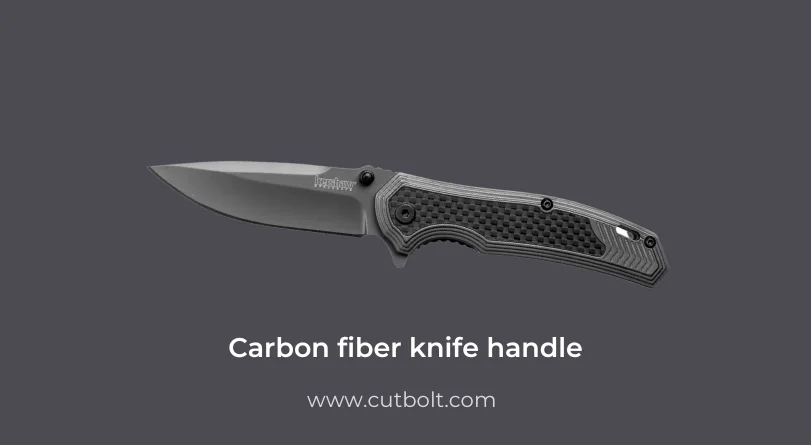
2. Plastics
Like metals, plastics can be divided into different categories: thermoplastics, elastomers and thermosets. Without going into too much detail, thermoplastics are malleable under heat, while elastomers have rubber-like elastic properties. Thermosets, on the other hand, take on their final shape on first cooling, but are of less interest to us when it comes to knife handles.
2.1. Thermoplastics knife handles
- ABS is the acronym for acrylonitrile butadiene styrene, a barbaric name for a plastic material, more precisely a thermoplastic, as you’ve probably guessed. It’s a material that’s frequently encountered because, in addition to being “cheap”, it offers interesting properties such as good resistance to impact and humidity. As the icing on the cake, ABS is recyclable, and this ergonomic material is often found on kitchen and survival/bushcraft knives.
- Zytel is probably a word that doesn’t mean anything to you, or only vaguely, yet many top brands use it, such as Ka-Bar, to name but one. This material offers many advantages, such as excellent resistance to shock, heat and rigidity.
2.2. Elastomers knife handle
- Rubber is a material that should appeal to those who wish to have a knife with the most ergonomic handle, i.e. one that’s most comfortable to handle. Rubber is often non-slip, making it ideal for demanding outdoor use. What’s more, it’s also very hard-wearing, making it the ideal material for knife handles!
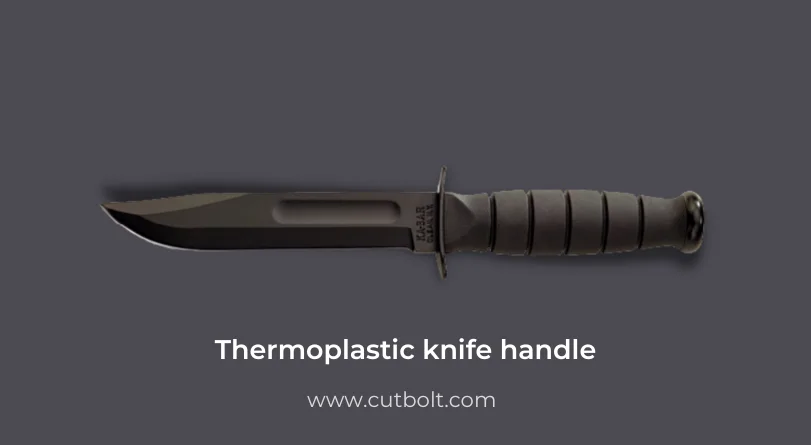
3. Organic knife handle materials
Organic materials are derived from the living beings that surround us. In fact, they were the first to be used by mankind. Organic materials can be divided into two groups: those of animal origin (animals) and those of vegetable origin (plants).
3.1. Animal-origin knife handle materials
- Deer antler is a material used in many hunting knives. The very natural look of an antler handle is generally very appealing to hunters. The material comes naturally from the antlers of deer that fall and grow back each year, without causing the animal any pain. In addition to its remarkable but variable aesthetic appeal, an antler handle is also very robust.
- Horn is an organic material prized by knife makers and users alike. It can come from a variety of animals, including rams, buffaloes and cows. Depending on the animal, the horn will not have the same color; for example, cow horn is blond, while buffalo horn is black. It’s worth noting that some knife handles are designed with a horn tip made from the upper, massive part of the horn.
- Ivory is made from elephant or warthog tusks. Ivory knife handles are easily recognized by their creamy white color. However, this elegance is becoming increasingly rare as a result of species protection. Be careful not to confuse genuine ivory with ivoirine, which is obtained by mixing ivory powder with synthetic resin!
- Mother-of-pearl is also an animal organic material used in cutlery, although it is rarely encountered. It comes from the shells of certain molluscs and is easily identified by its magnificent iridescent sheen. Some knives have “mother-of-pearl” handles made of synthetic material with decorations that imitate mother-of-pearl.
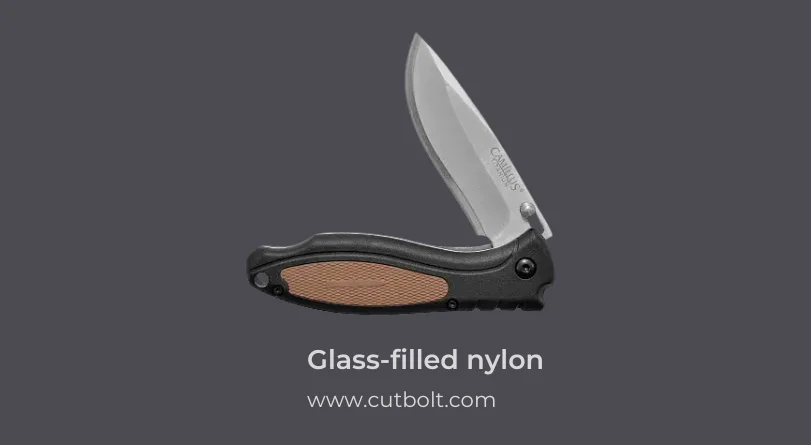
3.2. Plant-origin knife handles
When we speak of organic materials of plant origin, we immediately think of wood, which is obviously found on tree trunks.
However, the term “wooden handle” is very vague, as there are many different types of wood. Depending on the species chosen, the properties will differ, as will the price, which is highly variable.
There are two main categories of wood: European wood from Europe and exotic wood from countries or regions with a favorable climate.
3.2.1. European woods knife handle materials
- Boxwood is a familiar tree, found in abundance in Europe. It is a hard, light-colored wood with a fine grain and a yellowish color. Boxwood is widely used in cutlery, with many brands opting for this material for the handles of their knives.
- Birch is a light-colored wood used extensively for tool handles. Resistant, it has the advantage of having a grain with a certain uniformity, which is particularly aesthetic and decorative.
- Maple or sycamore is a wood that cabinetmakers particularly appreciate for its whiteness and discreet linear grain. It is found in France in various varieties (sycamore, plane and champêtre): maple is sometimes modified to change its color or further improve its properties.
- Beech is a brown, fairly light-colored wood that is relatively hard, making it shock-resistant. Its fine, even grain makes it particularly pleasing to the eye. Beechwood, for example, is widely used by the famous French Opinel brand.
- Walnut is a medium-hard, dark-brown wood with a medium grain. More sensitive to temperature variations and humidity, it can sometimes show knots, giving it a great deal of charm. Walnut tends to darken with age.
- Olive is undoubtedly one of the most widely used woods in cutlery. Around 20% denser than beech, olive is a highly resistant material with very tight pores. It is a richly-grained, irregularly colored wood, frequently found on pocket and kitchen knife handles for its antibacterial properties.
- Oak is a brown/yellow wood found in France and other European countries. Oak has a coarse grain and is a medium-hard wood, both durable and stable. Quite easy to work, oak is highly prized by cutlers, notably Opinel, who don’t hesitate to add engraved patterns as an added value.
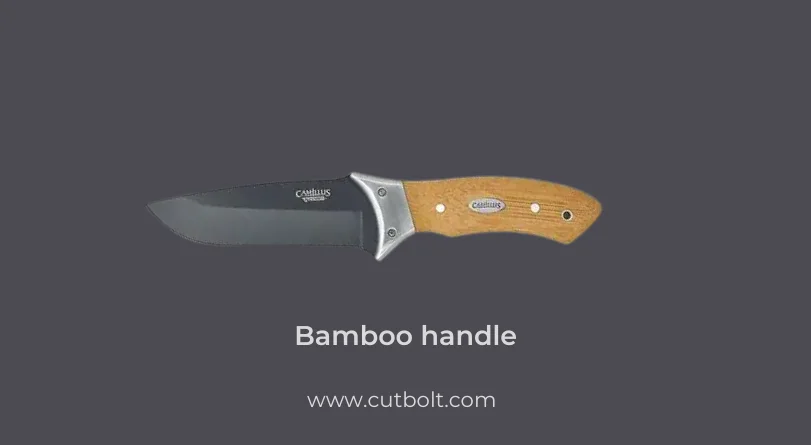
3.2.2. Exotic wood knife handle materials
- Ebony is an African wood, easily distinguished from other woods by its black color. Very heavy and sturdy, ebony is a sumptuous wood that’s quite expensive and is mainly used for top-of-the-range collector’s knives.
- Rosewood’s (not the Rosewood family) hue can vary considerably: from fairly light golden brown to very dark dark brown. For the record, its name comes from the fact that it is a particularly fragrant wood! Rosewood is elegant, robust and durable, which explains why it is so widely used in cutlery. Not to be confused with rosewood, a member of the rosewood family, which we’ll introduce below.
- Rosewood is a very hard wood that is highly resistant, including to humidity and pests. It’s a fairly expensive wood, which comes in a variety of shades, notably from America and Madagascar. Even though rosewood is very solid, it is easy to work and carve.
- Cocobolo is a type of wood identified by its beautiful reddish color. It comes mainly from Central American trees. If cocobolo is appreciated for its aesthetic appeal, it is equally appreciated for its solidity: it is a very hard wood offering excellent resistance to shock and water. Its ease of working makes it a favorite among knife makers.
- Padouk is a wood native to Central Africa, and is the benchmark of its kind on the African continent. This exotic wood is red in color and tends to gray over time. Easy to maintain and very hard, padouk can nevertheless retain its original shine by applying a saturator once or twice a year.
- Ziricote comes mainly from trees in Central and South America (notably Mexico). This precious wood ranges in color from medium to dark brown. Because of its highly irregular patterns, ziricote is unlike any other wood species. However, ziricote handles are still rare among knives!
- Bocote wood also comes from South America and Mexico. It can be recognized by its yellowish color and multiple streaks of brown and black. This precious wood is used by Italian cutlery maker Maserin, although it is also rarely used.
- Violet wood (formerly bois violet) is a precious wood native to Brazil (South America). Its color varies from brown to violet and even yellow in some cases, and it is a hardwood. French cutler Roger Orfèvre used violet wood to make the handles of certain K2 knives.
Good to know about wood
Because wood is a living material, its color can change over time, giving it a patina. With regular maintenance, however, it is possible to delay or even prevent this aging process. Maintenance means not only the use of oil or varnish, but also rigorous daily care, avoiding prolonged immersion in water.
It’s also important to bear in mind that each wood is unique in terms of its grain and defects (burrs, burls, burls). So when you buy a knife, even if the species of wood used is the same, the handle will not be exactly the same as the one next to it!
What is stabilized wood?
Manufacturers and cutlers quickly realized that many knife owners don’t have the desire or motivation to maintain their wooden handles. So they came up with the idea of injecting resin into the handle, known as stabilized wood. The aim is both to increase overall strength and to prevent stains from quickly appearing if the handle is not properly maintained. All woods can be stabilized, European as well as exotic!
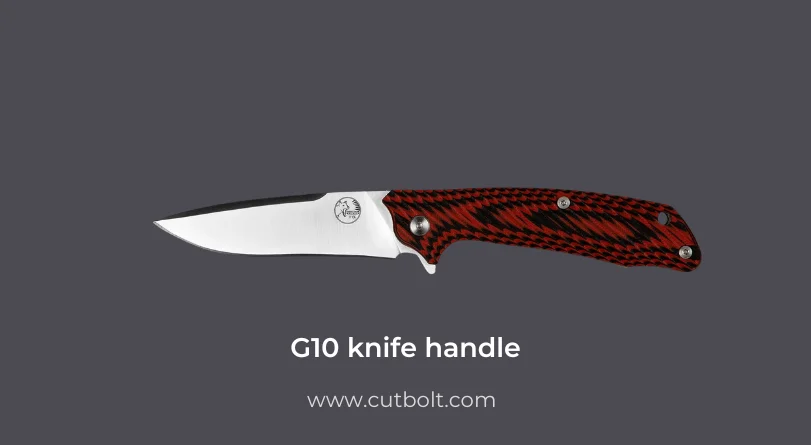
4. Composite knife handle materials
Simply put, a composite is an assembly of several materials. Often consisting of a framework and a protection, composite material is widely used in the manufacture of knife handles.
- G10: Composed of fiberglass and resin, G10 combines technical and aesthetic qualities, hence its widespread use in cutlery. It’s light, durable and robust, and not susceptible to rust or oxidation. The reasons for its success are now much clearer!
- Micarta is the result of mixing resin with fabric, canvas or paper. It’s a material we come across very often because of its many advantages: shock resistance, moisture resistance, and durability, not to mention its price!
- Carbon fiber is a material made from very fine fibers and carbon atoms. Regularly used as a reinforcement (“backbone”) for composite materials, carbon fiber ensures lightness and strength. Depending on the application, it can have a woven appearance.
- FRN/GFN: You may have come across the FRN/GFN markings on knife handles, without really knowing what they mean. FRN stands for “Fiberglass Reinforced Nylon“, while GFN stands for “Glass Filled Nylon“. These are highly resistant, injection-molded plastic materials, enabling knife manufacturers to texture them for style and ergonomics. With their infinite possibilities, these materials are also inexpensive. Many American brands, such as Spyderco, use FRN/GFN.
Related: Micarta vs G10 which is better for knife handles?

Summary: Knife handle materials
Now that your knowledge of materials is more advanced, you have all the cards in hand to make the right choice. As is often the case, the choice depends on a number of criteria, including use, budget and taste.
Generally speaking, for intensive outdoor use, the easiest thing to do is opt for a resistant, low-maintenance handle, such as a composite.
For more occasional use or for collecting, wood is suitable, but you need to be careful about the species you choose, as it can greatly vary the price.
This advice should be taken with a grain of salt, however, as it does not take into account your own tastes, which are an important factor. Don’t forget that aesthetics are one thing, but you also need to pay attention to the shape of your knife’s handle, so that it fits snugly in your hand and is always comfortable to use.
Knowing the main materials used for handles is all well and good, but to become an expert, we recommend that you carefully read our guide to knife steels.
Sources:
- https://en.wikipedia.org/wiki/Mollusca
- https://www.wood-database.com/african-padauk/
- https://www.twi-global.com/technical-knowledge/faqs/what-is-a-thermoplastic
- https://www.higonokami.jp/en/index.html
- https://www.foxcutlery.com/
- https://steelwillknives.com/steelwilladvantages/materials/tpe-handle.html

